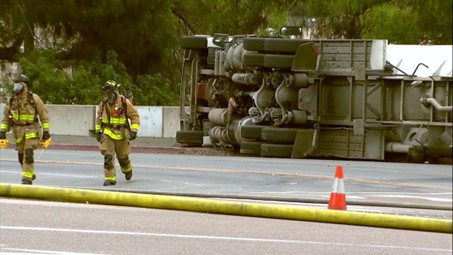The San Diego Running Company team was well on their way to producing the fourth annual America’s Finest Corporate Dash 5K on June 20 without a hitch. That changed 90 minutes before the event, when an oil tanker flipped on its side, blocking the entrance to the event venue at SDCCU Stadium.
It was the kind of unexpected race day incident that makes up event producers’ worst nightmares – uncontrollable, hard to plan for in advance, and could have easily derailed the entire late afternoon run for 2,000 runners, vendors and spectators. San Diego area businesses create employee teams for the annual event, promoting wellness and creating a fun sense of inter-company competition.
But when SDRC co-founders Eric Marenburg and Pete Hess walked out to the main road to assess the tanker accident, a fire captain quickly warned them away from the messy accident scene and said they’d have to call off the event. Not only was it blocking the main entrance to the stadium, it was right next to the planned 5K course.
This is not the what you want to hear when most of your participants are already on their way.
“When (the fire captain) told us we’d have to call it off, obviously our hearts stopped,” Marenburg said. But he and Hess weren’t willing to fold up their tents and go home without looking for a workaround. Thankfully, neither was the SDCCU stadium manager. They immediately began strategizing to figure out alternate ways for the participants and vendors to get to the stadium parking lot, and quickly communicate that change to the registered runners.
“We sent an email to all participants, briefly explaining there’s major accident going on, and we are going to delay the start of the 5K by 30 minutes just to give ourselves a little bit of runway,” he explained.
SDRC utilizes the Race Roster registration and customer relationship management (CRM) platform, which enabled them to easily communicate via email to all of the registered participants for the event. Race Roster had also sent a team member onsite for the race who helped make sure everything went smoothly
That communication turned out to be key in managing participant expectations. Runners were not surprised when they arrived at the venue, nor did they have to worry that traffic was taking them a bit longer to enter the stadium and park than they might have anticipated.
A secondary entrance to the parking area was used and a large digital blinking arrow sign that happened to be on site was utilized to let drivers know where to go. The new entrance was ahead of the closed entrance, which was beneficial.
Vendors for the post-event festivities, however, were arriving early than the participants and were turned around from the main entrance by police. They ultimately did make it into the stadium, just a bit behind schedule.
Here are some of the key takeaways from the incident, the first of its kind for SDRC, that Marenburg shared:
• Keep a cool head. More than anything else that the SDRC team did during their response to the incident, keeping a calm and even-keeled demeanor was perhaps the most important aspect of their success. “For every event we take on we’re all programmed to roll with the punches and adapt to the circumstances,” Marenburg said.
• Strong staffing can help overcome the unexpected. Having experienced pros on the team, who have worked on major events, made the response to an unexpected challenge even easier.
• Know your numbers – phone numbers, that is, for anyone and everyone you might need to contact in the event of an unexpected event situation. This includes vendors, venue managers, public officials, technology providers and emergency services personnel.
• Consider having a secondary course ready in advance. Even if not fully mapped, knowing your options for an alternative route can save you time when reaction time is limited.
• Have strong knowledge of your venue’s entrance, exits and alternative ways to access available parking lots. Don’t wait to depend on others to present secondary options – it will cost time and could even cost you your event.
• Make sure your event participant email database is easily accessible. In this instance, use of the Race Roster platform enabled runners to be easily notified and resulted in no complaints from participants on how the accident was handled.
• Just because you haven’t thought of it in advance, doesn’t mean you can’t handle it. A sideways oil tanker wasn’t on the list of contingencies that SDRC had planned for, but they emerged from the test unscathed.

